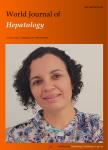Prevalence of non-alcoholic fatty liver disease in patients with nephrotic syndrome:A population-based study
作者机构:Internal MedicineCleveland Clinic FoundationClevelandOH 44111United States Digestive Disease and HepatologyCleveland Clinic Foundation FloridaWestonFI 33331United States Department of Medicine&SurgeryGeneral Hospital Lagos IslandLagos Island 101223LagosNigeria Department of MedicineRoss University School of MedicineBridgetown B11093St MichaelBarbados Digestive Disease and HepatologyCleveland Clinic FoundationClevelandOH 44111United States
出 版 物:《World Journal of Hepatology》 (世界肝病学杂志(英文版)(电子版))
年 卷 期:2023年第15卷第2期
页 面:265-273页
学科分类:1002[医学-临床医学] 100201[医学-内科学(含:心血管病、血液病、呼吸系病、消化系病、内分泌与代谢病、肾病、风湿病、传染病)] 10[医学]
主 题:Non-alcoholic fatty liver disease Nephrotic syndrome Chronic kidney disease Hyperlipidemia Population-based study Database
摘 要:BACKGROUND Non-alcoholic fatty liver disease(NAFLD) is a global health concern with a prevalence of about 25% amongst United States adults. Its increased prevalence is attributed to increase in patients with obesity and metabolic syndrome, partly due to similar mechanisms of injury. Nephrotic syndrome(NS) is a clinical entity resulting from extensive proteinuria leading to hypoalbuminemia, hyperlipidemia, edema, and other complications. Given its association with hyperlipidemia, there is concern that patients with NS may be at increased risk of *** To perform a cross-sectional population-based study to investigate the prevalence and risk factors of NAFLD in patients with *** A large multicenter database(Explorys Inc., Cleveland, OH, United States) was utilized for this retrospective cohort study. A cohort of 49700 patients with a diagnosis of “Non-Alcoholic fatty liver disease using the Systematized Nomenclature of Medicine-Clinical Terms(SNOMED-CT) between 1999-2022 was identified. Inclusion criteria were age ≥ 18 years, presence of NAFLD, presence of NS. There were no specific exclusion criteria. Univariate and multivariate analysis were performed to adjust for multiple risk factors including age, gender, Caucasian race, NS, type Ⅱ diabetes mellitus, hypothyroidism, dyslipidemia, obesity, metabolic syndrome and chronic kidney disease. Statistical analysis was conducted using R, and for all analyses, a 2-sided P value of 0.05 was considered statistically *** Among the 78734750 individuals screened in this database, there were a total of 49700 subjects with NAFLD. In univariate analysis, the odds of having NAFLD in patients with NS, type 2 diabetes mellitus, hypothyroidism, dyslipidemia, obesity, metabolic syndrome and chronic kidney disease were 14.84 [95% confidence interval(95%CI) 13.67-16.10], 17.05(95%CI 16.78-17.32), 6.99(95%CI 6.87-7.11), 13.61(95%CI 13.38-13.84), 19.19(95%CI 18.89-19.50), 29.09(95%CI 28.26--29.95), and 9.05(95



